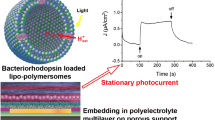Abstract
Bacteriorhodopsin (BR) is a photochromic membrane protein isolated from a strain of halobacteria. Embedment of BR into a polymeric matrix enables the application of the photoactive protein as an optical material. In this work, a chemically cross-linked BR/gelatin film was prepared. The cross-linked film was found to be highly stable even under extreme alkaline or detergent circumstance while BR maintained its bioactivity. The treatments of base and detergents also led to dramatic prolongation of the lifetime of M photoproduct, which might be beneficial for potential applications such as information storage. The BR/gelatin film was demonstrated to tentatively record a simple pattern.
Similar content being viewed by others
References
Lanyi JK, Luecke H. Bacteriorhodopsin. Curr Opin Struct Biol, 2001, 11(4): 415–419
Wu AG, Jia ZH, Schaper A, Noll F, Hampp NA. Simultaneous removal of thiolated membrane proteins resulting in nanostructured lipid layers. Langmuir, 2006, 22(12): 5213–5216
Mukhopadhyay AK, Bose S, Hendler RW. Membrane-mediated control of the bacteriorhodopsin photocycle. Biochemistry, 1994, 33(36): 10889–10895
Pabst R, Nawroth T, Dose K. Time-dependent monomerization of bacteriorhodopsin in Triton X-100 solutions analyzed by high-perform ance liquid-chromatography. J Chromatogr A, 1984, 285(2): 333–341
Hampp N. Bacteriorhodopsin as a photochromic retinal protein for optical memories. Chem Rev, 2000, 100(5): 1755–1776
Ming M, Lu M, Balashov SP, Ebrey TG, Li QG, Ding JD. pH Dependence of light-driven proton pumping by an archaerhodopsin from Tibet: Comparison with bacteriorhodopsin. Biophys J, 2006, 90(9): 3322–3332
Ming M, Wang YZ, Wu J, Ma DW, Li QG, Ding JD. Triton X-100 can alter the temporal sequence of the light-driven proton pump of archaerhodopsin 4. FEBS Lett, 2006, 580(28-29): 6749–6753
Wu J, Ma DW, Wang YZ, Ming M, Balashov SP, Ding JD. Efficient approach to determine the pK(a) of the proton release complex in the photocycle of retinal proteins. J Phys Chem B, 2009, 113(13): 4482–4491
Birge RR, Gillespie NB, Izaguirre EW, Kusnetzow A, Lawrence AF, Singh D, Song QW, Schmidt E, Stuart JA, Seetharaman S, Wise KJ. Biomolecular electronics: Protein-based associative processors and volumetric memories. J Phys Chem B, 1999, 103(49): 10746–10766
Yao BL, Li BF, Li XC, Hampp N. Long lifetime M state optical storage in genetic mutant bacteriorhodopsin film. Prog Biochem Biophys, 2001, 28(6): 844–847
Liu SY, Ebrey TG. Photocurrent measurements of the purple membrane oriented in a polyacrylamide gel. Biophys J, 1988, 54, 321–329
Liu J, Ming M, Liu J, Huang L, Li QG, Ding JD. Preparation and study of bacteriorhodopsin/poly(vinyl alcohol) composite film. Acta Chimica Sinica, 2002, 60(12): 2209–2213
Ma DW, Ming M, Hong J, Wu J, Li QG, Huang WD, Ding JD. A membrane protein/polymer composite film with photochromic response. Acta Polymerica Sinica, 2006, 9: 1078–1082
Ma DW, Zhao YC, Wu J, Cui T, Ding JD. A block-copolymer hydrogel encapsulates bacteriorhodopsin and produces the longest photochromic response of the membrane protein under high water content conditions. Soft Matter, 2009, 5(23): 4635–4637
Ma DW, Wang YZ, Wu J, Zhao YC, Ming M, Ding JD. Amphiphilic block copolymers significantly influence functions of bacteriorhodopsin in water. Soft Matter, 2010, 6(19): 4920–4930
Teng XL, Lu M, Zhao YY, Ma DW, Zhao YC, Ding JD, Huang WD. Photoinduced nonlinear refraction in a polymeric film encapsulating a bacteriorhodopsin mutant. Appl Phys Lett, 2010, 97(7): 071109(1)–071109(3)
Zhao YC, Ming M, Hong J, Ma DW, Wu J, Li QG, Huang WD, Ding JD. Preparation of a gene-engineering mutant of bacteriorhodopsin BR-D96V and corresponding poly(vinyl alcohol)-based functional composite films. Chinese Sci Bull, 2010, 55: 3825–3830
Weetall HH, Druzhko AB. Optical and electrical characteristics of bacteriorhodopsin gelatin films and tin-oxide coated electrodes. Curr Appl Phys, 2003, 3(2-3): 281–291
Korchemskaya E, Burykin N, de Lera A, Alvarez R, Pirutin S, Druzhko A. 14-Fluoro-bacteriorhodopsin gelatin films for dynamic holography recording. Photochem Photobiol, 2005, 81(4): 920–923
Liang B, Li LQ, Li ML, Li BF, Jiang L. Photochromic properties of chemically modified bacteriorhodopsin films. In: Lewis KL, Meerholz K. Eds. In: Proceedings of The Society of Photo-optical Instrumentation Engineers. San Jose: SPIE-Int Soc Optical Engineering, 2000, 4104: 64–70
Park SN, Park JC, Kim HO, Song MJ, Suh H. Characterization of porous collagen/hyaluronic acid scaffold modified by 1-ethyl-3-(3-dimethylaminopropyl)carbodiimide cross-linking. Biomaterials, 2002, 23(4): 1205–1212
Kuijpers AJ, Engbers GHM, Krijgsveld J, Zaat SAJ, Dankert J, Feijen J. Cross-linking and characterisation of gelatin matrices for biomedical applications. J Biomater Sci Polymer Edn, 2000, 11(3): 225–243
Siebert F, Mantele W, Kreutz W. Evidence for the protonation of two internal carboxylic groups during the photocycle of bacteriorhodopsin — Investigation by kinetic infrared-spectroscopy. FEBS Lett, 1982, 141(1): 82–87
Otto H, Marti T, Holz M, Mogi T, Lindau M, Khorana HG, Heyn MP. Aspartic acid-96 is the internal proton donor in the reprotonation of the schiff-base of bacteriorhodopsin. Proc Natl Acad Sci USA, 1989, 86(23): 9228–9232
Author information
Authors and Affiliations
Rights and permissions
About this article
Cite this article
Wang, Y., Wu, J., Ma, D. et al. Preparation of a cross-linked gelatin/bacteriorhodopsin film and its photochromic properties. Sci. China Chem. 54, 405–409 (2011). https://doi.org/10.1007/s11426-010-4213-7
Received:
Accepted:
Published:
Issue Date:
DOI: https://doi.org/10.1007/s11426-010-4213-7




